Lincoln, Lincolnshire
Up to 1834
Lincoln had a workhouse from about 1740. A parliamentary report of 1777 recorded Lincoln parish workhouse as having accommodation for up to 60 inmates. Metheringham also had a workhouse for 15 inmates.
Eden, in his State of the Poor published in 1797, reported on poor-relief in Lincoln:
In 1796, (just after Eden's report was compiled) a private act or parliament "for the better Relief and Employment of the poor of the several Parishes within the City of Lincoln and County of the same City" set up a body known as the "Directors of the Poor". In March 1797, the existing House of Industry was purchased for £730 for the use of the 13 city parishes. The surviving Directorate's Minute books from 1796 to 1832 give a fascinating insight into the workings of a town workhouse prior to 1834. The account below is adapted from a 1940s survey of these records by the Rev. E.R. Milton, then Chaplain to the Lincoln Public Assistance Institution.
Lincoln's House of Industry
The premises consisted of a large square building facing east, with a smaller oblong attachment at the rear, and another large room in the front. They were sufficiently spacious to contain a Board room, a Dining room, a Reception room, rooms numbered and fitted with locks for the occupation of the inmates; some penitentiary cells, and a number of outbuildings.
New admissions were received into one big room, heated by an iron stove, until they were certified clean and fit for reception into the House. Even so, and although the rooms were kept whitewashed one of the directors was deputed "to superintend the destroying of bugs in the House, and that he be desired to procure such ointment as may be wanted."
The First Bath.
In 1799 four women were appointed "to wash and comb the children," and were designated nurses, and the next year the directors actually bought one "bathing tub" for the use of the House. The furnishings were severely utilitarian, and not elaborate. In 1799 a local tradesman was asked to supply 24 iron bedsteads, and an order was given for "half-a-dozen strong-armed chairs." At a later date the furniture of the building was insured for £150.
The actual management of the Institution was in the hands of a governor and matron — usually husband and wife. In addition to their salary they received many perquisites, and, it is to be feared, were not always honest in their administration. The first governor mentioned in the minutes had to be dismissed for petty theft at the end of the first year. The joint salary of his successors in 1800 was fixed at £35 a year, and a commission of 1s. 6d. in the pound, with minor exceptions, on the earnings of the inmates.
On one occasion the governor was allowed to take for his own use the clothes of a deceased inmate. In 1809 it was ordered that "none of the poor in the House hire themselves to work, but that the governor hire them out and receive their wages" for which he was required to account to the directorate. The next year, however, there was again some financial irregularity when he was unable to account for certain sums and henceforth he was forbidden to handle any money on account of the House. In 1827 the governor and matron had their salary raised to £55 per annum, and in 1830 the governor was required to undertake the stocking of the farm.
Among the inmates were to be found all sorts and conditions of men. Besides the genuine poor and aged there were the refractory and the work-shy, as well as others who had fallen on evil times.
In 1812, a woman and her four children, all under the age of six years, had to be admitted into the House owing to her husband being committed to the Debtors' Prison in the Castle.
Perhaps the most frequent subject with which the Directors had to deal was the care and maintenance of illegitimate children born in the institution, and of unmarried mothers, chargeable to the rates. These cases usually entailed enquiries for reputed fathers with a view to securing financial reimbursement. The women also had to be sworn to their settlement, and arrangements made for their maintenance or return to their own locality.
Keeping Them Employed
The chief occupation among the women was spinning. In 1799 the minutes refer to the repair of the Jersey wheels for spinning hemp, and record an order upon Claypole Mill for the supply of one hundredweight of hemp to be spun for sacking.
We also find "ten or twelve tods of wool" purchased for the manufacture of Wolsey cloth. In 1810 this activity was extended when it was agreed "to give flax to the out-poor to spin at 10d. a lb." but in 1828 it was decided, "That no more Wolsey cloth be manufactured, and the remainder of the wool be made into petticoats."
For the men some heavier type of work was felt desirable, such as gardening and breaking stones for road repairs. Frequently their labour was let out on hire, as in the case of Joseph Lee, who, in 1809, was sent to work for Mr. Doughty, of Bailgate, a rope maker, for 13 weeks at 4d. a day.
Others were posted to farmers and to brick-makers' fields. Craftsmen were frequently employed in their own line of business in the service of the House, as was Robert Bradshaw, of Brauncewell, who, in 1826, was set to work as shoemaker, perhaps under protest, certainly without gratuity and under threat of penalty.
The wages earned in all these ways were claimed by the Institution, a commission being paid to the governor and matron as already mentioned, and, usually, a very small gratuity allowed to the worker.
In 1827 the rate of wages was fixed at 6d. a day for boys under 12 years of age; 10d. a day for youths under 17, and 1s. 2d. for men, but in 1828 the gratuity paid to adult paupers "for work done in and out of the House for hire" was reduced to 1d. a day on the basis of good behaviour. In 1830 the scale of wages was set on a summer and winter basis, the net result of which was that from October to April boys under 12 earned 4d. a day; those under 17, 6d.; and men 10d. In 1811 William Rogerson was confined for four weeks in the cells "for absenting himself from the House and receiving wages for six days' labour amounting to £1 1s. 1d., and not accounting for the same to the House," and the clerk was instructed to write to the farm bailiff of Mr. Francis Chaplin and inform him that "the directors expect he will pay without delay the wages due for William Rogerson's labour." Another piece of work which was regularly undertaken by the House was the scavenging of the streets of the city on a contract of £35 per annum with the Corporation, and the proceeds of the auction of manure in advance.
Apprenticeships
One of the major concerns of the Directorate was the apprenticeship of children, and the minutes contain much illuminating information on this subject. Sometimes the children were apprenticed individually and locally to watermen, ropemakers, and to the sea. A number of children, boys and girls, were apprenticed to framework knitters at Southwell, North Collingham. Bingham and other Nottinghamshire villages, but more often the girls were sent into domestic service at a wage of 6d. or a 1s. a week.
An interesting case occurs in 1810, when a lad was apprenticed to a woman chimney sweep in the parish of St. Peter-at-Gowts. Normally a guinea was spent in providing them with necessary clothing, and they were presented with either a Prayer Book or a Testament. Others in small numbers were sent to the candlewick manufacturers at the Claypole Mills near Newark. But in 1797 a batch of no less than 22 pauper children, boys and girls, and, in some instances, brothers and sisters, belonging to the city and country parishes, were apprenticed to the Lancashire cotton mills at Bolton, and the employers given five pounds towards the expense of removing them.
The average age of these children was about ten years. A few months later an anonymous complaint concerning their welfare was received by the Board of Directors, but, although some enquiry was ordered, no record has been preserved of any action taken on their behalf.
It was to protect children of this category that the first Factory Act was promoted in 1802. But in the first half of the nineteenth century the apprenticeship of pauper children steadily declined in favour; employers found that they could engage free labour, which was usually better labour, at little extra cost, and one of the last minutes recorded on 5 December, 1832, gave notice of a motion to be laid before the next meeting of the Board of Directors designed to compel local tradespeople to take parish apprentices s under an old statute of William III.
Monotonous Life.
There were always a number of young children in the House. Their life must have been a very monotonous one, and, apart from the erection of a swing, no provision seems to have been made for their recreation. However, some attempt was made at their education. In 1798 the chiphouse was converted into a school room, the window enlarged and made to open, a stove fixed in the corner, and an advertisement put into the "Lincoln and Stamford Mercury" for a school mistress.
In 1826 the boys attended the National School in Silver-street, and some of them apparently were of sufficient attainment to be used as monitors for teaching the younger children.
In 1827 the board complained of the treatment of the children by the Master, and in 1829 decided to discontinue its subscription of five pounds per annum, and to take the children from the school. New arrangements were made for their instruction on the premises, and the hours fixed as follows: From 9 to 12 in the morning, and from 2 till 5 in the evening. A bell was to be rung for morning opening, and a minute was recorded, That Francis Green (an inmate) be allowed an additional allowance of meat on the meat days, and cheese for his supper every night, and gratuity of 2s. 6d. per quarter for teaching the children, and that Samuel Glover have the same allowance of meat and cheese for assisting in the teaching of the children."
The Pre-ration Period.
The diet of the inmates appears to have been ample and substantial. Soon after the new Board had taken over the premises in 1797 a committee was appointed to draw up a weekly dietary. Under this scheme there were three meals a day.
Breakfast consisted of a pint of milk porridge, with 6½ozs. of bread for adults; dinner comprised 8ozs. of meat, 6ozs. of bread, a trencher full of roots or greens, and a pint of beer. For supper adults were allowed a pint of broth and 6½ozs. of bread. Potato suppers three times a week consisted of a full trencher and a pint of beer, bread and cheese suppers twice a week consisted of 3ozs. of cheese and 6½ozs. of bread.
The children enjoyed the same fare in proportion to their age and work. The meat was usually beef which the Board directed should consist "only of rounds and flanks."
The beer was supplied by a local tradesman at the rate of 10s. per hogshead; and Nottingham cheese by another trader at 5½d. lb. Potatoes were purchased in bulk, about 1,500 pecks at a time, at 3d. per peck. White peas for pea soup were supplied at 40s. a quarter.
In 1827 tea cost the House 5s. 4d. lb. Christmas Day fare was invariably beef and plum pudding. The inmates going out to work took with them 1lb. of bread and the usual allowance of cheese, and had an extra halfpound of bread for supper. In 1809 adults were allowed 3d. and children 1d. instead of the usual allowance of ale on Christmas Eve, and gratuities from tradesmen to inmates for ale were discouraged.
Owing to the poor harvest of the previous summer and the Continental war the winter of 1799-1800 was a very severe one. Wheat stood in the neighbourhood of eight guineas a quarter, and the price of bread rose from is 3d. per quartern loaf in January to 1s. 6½d. in the following June. Under the heading of 1880 the Lincoln Date Book says that, "In consequence of the distress of the lower orders, the House of Industry, or workhouse, above hill, increased to a great degree." Colds and other ailments were so prevalent that the clerk was instructed by the Board to purchase two gallons of rum "for the use of the House."
Rum on the "House".
The Board must have been proud of its allowance of beverage to the inmates. In January, 1798, it purchased 24 pint and 12 half-pint mugs, probably for beer, and the men who worked in the garden were allowed an extra pint of ale per day. About the same time complaint was made to the supplies concerning the quality of the beer, and it was threatened that unless it improved the contract would cease.
In 1809 the Board called upon the physician to substantiate hi: assertion 'that none of the working poor are ever allowed a drink of beer in the day." That year they paid Mr. Trotter 12s per hogshead for beer, and 4s. a strike for grains.
Most commodities were purchased by tender from local traders, and in 1832 it was decided to buy flour instead of wheat which, presumably, the House had previously had its own means of milling. In 1830 it was ordered that all able-bodied and casual paupers should be fed on bread and cheese and water, "and have no meat allowed them" as an extra inducement to work.
In the early years coal was purchased for the use of the Institution by the boat load, and in 1809 a Mr. Dauber was engaged to supply the House with "Dukes or Park Gate coals" for one year at 16s. 6d. per chaldron, "no metage to be paid by the House, and the coals to be taken out of the boats upon notice given to the House."
In Canvas Trousers.
The records contain some very illuminating details concerning the clothing of the inmates. In 1791 the treasurer was instructed to buy up 33 hats, "which the governor has met with" at 3d each Later in the year we find an order placed for "three gross each of horn coat and breast buttons, 3lbs. of coloured thread 20 yards of canvas, and one gross of stay tape," which sounds as though some of the male inmates were to be equipped with canvas trousers. For the boys a dozen pairs of leather breeches were purchased.
In 1800 an order is given for a dozen worstead caps for a similar purpose. In 1827 it was ordered, "That all the inmates of the House be universally cloathed with the dress of the Institution, and that no person be permitted to go out of the House in any other dress." Also "that the porter (an inmate) have a new suit of clothes, and that his coat be blue with a red collar."
In the following year the dress of the inmates was prescribed as follows: "That the dress for every female inmate of this establishment consist of a black bonnet or cotton white cap, dark cotton gown and slip, a red flannel petticoat, black stockings and blue neckerchiefs; that the dress of the male inmates consist for men of a complete suit of grey cloth; for boys a complete suit of fustian dress and grey stockings and blue neckerchiefs for each."
And Wooden Shoes.
At the same time two dozen wooden shoes of various sizes were ordered. The next month a dozen pairs of men's and a dozen pairs of boys' clogs were ordered from Wakefield, and in September it was decided that instead of entering into contracts for the supply of goods, clothing included, in future "to buy every article in the best and cheapest manner."
Under an Act of Parliament passed in 1696 the parish poor were required to wear the initials of the place to which they belonged on a shoulder patch. It was an official confirmation of local custom in many districts, and Overseers' accounts frequently contain items of expenditure for "badging the poor." The system was adopted by the Lincoln House of Industry with a slight variation, and the minutes for 1 August, 1797, record instructions given for procuring "100 cast copper medals for the use of the House."
From the beginning, medical attention for the inmates was secured by tender, and the first appointment of a visiting physician was made in 1797 at a salary of twenty-five guineas per annum. The next year it was ordered that all inmates who had not had small-pox should be inoculated by the "House apothecary, and that he be allowed 3s. 6d. per head for inoculating them."
Possibly there was an epidemic in the city about this time, for we find the directors voting a sum of five guineas "towards the Fund for inoculating the poor of this town." This treatment for small-pox was still in a very experimental stage, for it was not before 1789 that Jenner made his first trials with swine pox matter, and not till 1796 that he actually inoculated a child with cow pox virus from another patient.
Ruled with an Iron Rod.
The disciplinary system of the establishment was severe, and seems to have merited the strictures of Sir Robert Heron, Squire of Stubton, Magistrate, and M.P. for Grimsby, who, in 1816, wrote in his "Notes" that "The workhouse was managed well as to food, cleanliness and order, but it was ruled with an iron rod, and chains and dungeons were in constant use for trivial faults, and at the will of the governor. It was also totally without means of complaint for the unfortunate inhabitants."
It was this feature which persuaded him to establish a House of a more humane character in his own neighbourhood. Actually, his was not the first criticism, for as early as 1797 the clerk was directed to send "a copy of the clause in the Act of Parliament respecting poor guilty of misbehaviour being punished in the House with one of the bye-law, to Mr. Alderman Parsons, the Directors apprehending he is not acquainted with their power." But if the alderman was not acquainted with their power the inmates certainly were. The records of the Lincoln House of Industry are full of penalties for all sorts of offences.
In July, 1797, William North was put into the penitentiary house for 24 hours for getting drunk. For a similar offence William Brand was punished in the same way, and not allowed out of the house for the next two months, while Mary Close was confined to the premises for three months "as a punishment for her leaving the House without leave."
For "begging in the town and coming home in liquor," Elizabeth Bailey was confined for three months.
At the end of 1799, Catherine Smith was put on a diet of bread and water for a day, and confined three months for going out without leave, and abusing Joseph Colton. But the said Catherine seems to have been a difficult proposition, for a few months later she was confined in a penitentiary cell for 24 hours on bread and water "for neglecting and not performing her task work and abusing the matron." The very next week she was in trouble again "for breaking a wood dish, when she was last confined."
Drastic Treatment.
Elizabeth Ryall was, for some unknown reason, kept in durance in the cells but was to be permitted to come into the House luring the day, "when she is to wear a wooden clog chained to her leg."
That the punishment was sometimes extreme is shown in the case of Robert Dent, who, on 1 August, 1809, was ordered to be "confined in one of the cells for four weeks for leaving the House on 31 July last without leave." It was drastic treatment for a poor wretch, who could not have been at large for more than a few hours.
In 1810 Joseph Lee was ordered to be "confined in one of the penitentiary cells for one week for stealing property from Mr. Doughty with whom he worked; that his diet be bread and water, and that he be publicly whipped every day during such time."
No doubt there was some difficulty in persuading a certain type of inmate to work, and the subject is dealt with in a minute of 6 June, 1809, "That in case any person in the House shall refuse to go to work when ordered by any of the committee of Directors for the general management of the House, or of the governor, he or she shall be confined in one of the cells for 24 hours, and until he or she promise to perform such work, and that during such confinement the diet be bread and water only."
Solitary confinement was the penalty for neglect of Sunday worship, or for roaming the streets or frequenting ale-houses on the Lord's day. But the cells were not the only form of punishment, and one of the earliest devices adopted was the stocks.
The minutes offer many illustrations of their use for different forms of delinquency, especially drunkenness and bad conduct, and they were sometimes used in conjunction with corporal punishment. Thus, in March, 1828, it was ordered "that John Blacksell be whipt, put into the Stocks one hour each day at dinner time for four days, be solitary confined, and have no meat allowed him for that period."
In the Stocks.
On another occasion John Burgess was confined for a fortnight, fed on bread and water, and set in the stocks for an hour for each of six days at dinner hour for receiving stolen property
William Espin was condemned to solitary confinement for a week, fed on bread and water and put into the stocks twice for an hour each time and flogged once for theft.
In the case of John Rustin and Daniel Shannon in 1825, it was ordered that they be "publicly, flogged for leaving their places," kept confined so as to prevent their going to the races; kept upon brew and water, and "well worked for the space of one month." On the other hand, William Hall was only to be moderately corrected with birch" for repeated theft.
Despite the strict discipline of the House, there were, apparently, occasions when it failed, and the authority of the magistrates had to be invoked. So in 1827 they were requested to punish David Thompson, Richard Lowndes, Isaac Webbellee, George Johnson, John Rustin and Samuel Tangate for bad conduct in the House, and in the following year Ann Gibbs was commended to their attention for punishment "as a lewd woman," and mother of three illegitimate children — all chargeable to the parish.
Church Parades.
The religious life of the inmates was not overlooked, and the minute hooks contain a number of references to the subject In the early years they attended the Church of St. Paul-in-the-Bail or St. Mary Magdalene, referred to as the "Chequer Church," according to convenience and under the supervision of one of their number, who was rewarded to the extent of 2d. a Sunday.
In 1809 the governor was expected to attend the inmates to and from worship at the Cathedral on Sunday
In 1798 the city clergy were taken into conference on the subject of providing a suitable form of prayer for use in the House but the memorandum submitted to the Directors afterwards was signed only by five clergy, and it would seem that the meeting was over-ruled by the domineering personality of the Rev. William Hett, who served a number of local churches as priest-in-charge besides holding a Cathedral appointment.
One of the signatories was the Rev. Dr. William Paley. the celebrated author of "The Evidence of Christianity," and sub-dean of the Cathedral. A form of prayer was subsequently drawn up and 500 copies printed under the supervision of the said Mr. Hett. He was officially thanked for his care and attention in compiling a set of prayers and admonitions to be used in this House, and also for his attendance in delivering the same to the poor therein."
The next year divine service was ordered to be read once a week in the House, and the Rev. George Kent was appointed chaplain at a salary of £10, raised in 1800 to £15, which was to include all occasional duty.
A Meddlesome Man.
Mr. Hett seems to have been of a most meddlesome nature, and in 1809 offered to read prayers in the House gratis — a temptation which the Board could not resist — and consequently Mr. Kent, who had originally been invited to accept the office, was given three months' notice to quit. However, before the end of the year Mr. Hett's conduct in the capacity of director gave such serious offence to the Board that even that long-suffering body had eventually to summon enough courage to dismiss him.
In the same year the inmates were permitted to attend their own denominational places of worship under the superintendence of someone appointed by the master and matron, and confinement in the solitary cell was inflicted on such as neglected public worship on Sunday, or spent the time in wandering or tippling.
In 1826 the Directors appear once more to have grudged the services of a stipendiary chaplain and ordered that "the office of chaplain to this Institution be discontinued." though within a few weeks they accepted the offer of gratuitous service from another cleric, whom they presumed to direct that he should keep a register of births in the House.
Throughout these years the visitation of relatives in the Institution seems to have been limited to one day a week: Wednesday for city visitors, and Friday for those coming in from the country.
Until the year 1800 paupers dying in the House were buried in the churchyard of St. Paul's which was the nearest parish church. In that year, however, the parish vestry had to make representations to the Directors that, in view of the requirements of the parish, it could no longer receive burials except in the case of inmates, who had formerly been parishioners. Arrangements were then made for the interment of others in the churchyard of their own parishes. But in 1827 the House had to appropriate a portion of its own land for the purposes of a cemetery.
Pauper Funerals.
From the minute books we get a number of details concerning pauper funerals in those days. Undertakers were appointed by contract, as was William Bescoby in 1828 to supply coffins at 12s. apiece, and in 1831 at 14s. apiece for paupers over the age of 12 years, and 5s. for those under that age.
At one time the burial ground of the establishment was let out to a local butcher at £1 per annum for the grazing of sheep, and in 1829 the House undertook the prosecution of a man suspected of being involved in body. snatching from the cemetery.
From time to time there were, of course, mild scandals. In 1800 it appears that Mr. Franklyn. the surgeon, made some indiscreet remarks at a dinner party to the effect that 250 paupers were kept in the House; that they were fed entirely upon barley bread, and were ill of various fevers and were dying daily.
The Directors were seriously perturbed by these allegations, and called for an investigation but the minutes do not record the conclusion of the incident.
The Board's Port.
Another, of a somewhat humorous flavour, occurs under the date 30 September, 1828, when a reward of 20 guineas was offered by the Board for the conviction of the persons responsible for the burglary of the Board room on the previous night when they removed "15 bottles of port wine." Evidently the weekly Board meeting was by no means a dry affair.
There were other difficulties also, not the least of which were the frequent attempts on the part of inmates to abscond from the Institution, involving advertisements and rewards for their apprehension, and the frequent journeying of the Governor to bring the miscreants back home.
According to the census taken in those years, the workhouse had 248 inmates in 1801, 118 in 1811, 120 in 1821, and 101 in 1831.
After 1834
Lincoln Poor Law Union was formed on 28th November 1836. Its operation was overseen by an elected Board of Guardians, 89 in number, representing its 86 constituent parishes as listed below (figures in brackets indicate numbers of Guardians if more than one):
City and Liberty of Lincoln:
St Benedict, St Botolph, Bracebridge, Branston, Canwick, St John in Newport, St Margaret-in-the-Close, St Mark, St Martin (2), St Mary-le-Wigford, St Michael, St Nicholas in Newport, St Peter at Arches, St Peter at Eastgate, St Peter in Goats, St Swithin (2), Waddington.
County of Lincoln:
Aisthorpe, Apley, Auborn, St Mary Magdalen in the Bail, St Paul in the Bail, Bardney (2), Barlings, Boothby, Boultham, Brattleby, Broxholme, Bullington, Burton, Cameringham, Caneby, North Carlton, South Carlton, Coleby, Dunholme, Dunstan, Eagle, Doddington, Faldingworth, East Firsby, West Firsby, Fiskerton, Friesthorpe, Goltho, Greetwell, Hackthorne, Haddington, Cold Hanworth, Harmston, Heighington, Holton by Beckeringham, North Hykeham, South Hykeham, Ingham, Metheringham, Navenby, Nettleham, Newhall (in Stainton), Nocton, Normanby, Owmby, Potter Hanworth, Rand, Reepham, Riseholme, Saxby, Saxelby with Ingelby, Scampton, Scothern, Skellingthorpe, Skinnand, Snarford, Snelland, Spridlington, Stainfield, Stainton (by Langworth), Sudbrooke, Swinethorp, Thorpe in Fallows, Thorpe-on-the-Hill, Washingborough, Welton, Whisby, Wickenby, Willingham Cherry.
The population falling within the Union at the 1831 census had been 30,230 with parishes ranging in size from Skinnand (population 24) to Lincoln St Swithin (2,202). The average annual poor-rate expenditure for the period 1834-36 was £5,356 or 3s.6d. per head.
The new workhouse was built 1837-8 at the west side of Burton Road, to the south of Long Leys Road. The architect was WA Nicholson who was also responsible for the Thurgarton Incorporation workhouse in Nottinghamshire. It was designed to accommodate 350 people and the Poor Law Commissioners authorized an expenditure of £6,650 for its construction. The old workhouse site was sold off for £400, and the buildings demolished in 1839.
The location and layout of the union workhouse can be seen on the 1887 map below. The entrance was at the east, at the end of a long driveway from Burton Road.
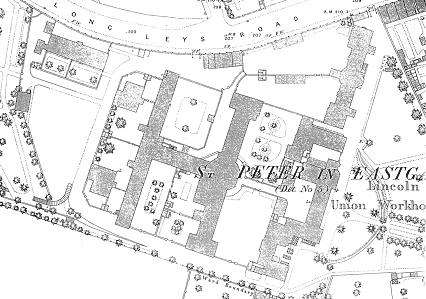
Lincoln workhouse site, 1887.
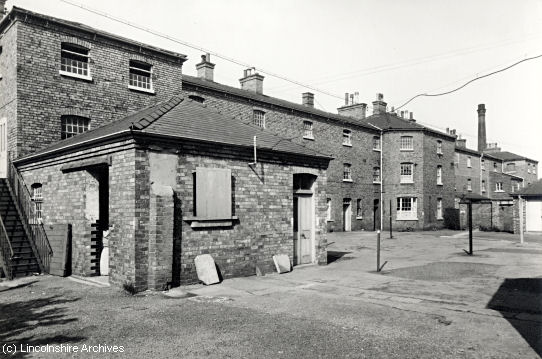
Lincoln main block from the south, c.1960.
© Lincolnshire Archives.
In 1879-80, a large building was added at the north-east of the site, in line with the main workhouse front block. This contained school rooms and children's accommodation and cost £12,000. The architect's design of the building's frontage is shown below.
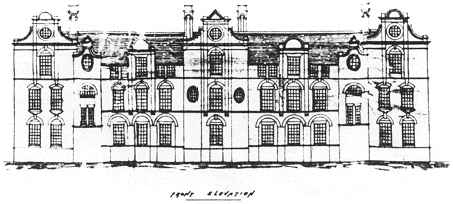
Lincoln children's block from the south-east.
The view below of the rear of the children's block dates from around 1965 when the building was being demolished.
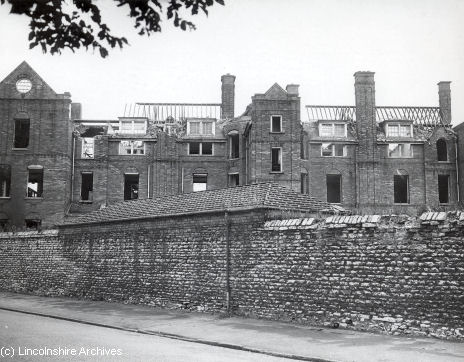
Lincoln children's block from the north-west, c.1965.
© Lincolnshire Archives.
From 1904, to protect them from disadvantage in later life, the birth certificates for those born in the workhouse gave its address just as Lincoln Home, 8a Burton Road, Lincoln U.D.
The Board of Guardians had their final meeting on 25th March 1930 when the commemorative picture below was taken outside the board room.
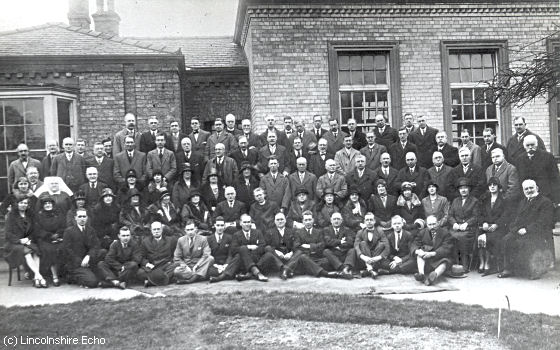
Lincoln Board of Guardians, 1930.
© Lincolnshire Echo.
After 1930, the workhouse became known as Burton Road Institution, then later as West View.
The former union workhouse buildings were demolished in around 1965.
Children's Homes
From the early 1900s, Lincoln Union operated several homes for pauper children. A girls' home was located on Long Leys Road, Lincoln, and a boys' home at Scothern. Other homes were located at 27-32 Saxon Street and on Rasen Lane, Lincoln.
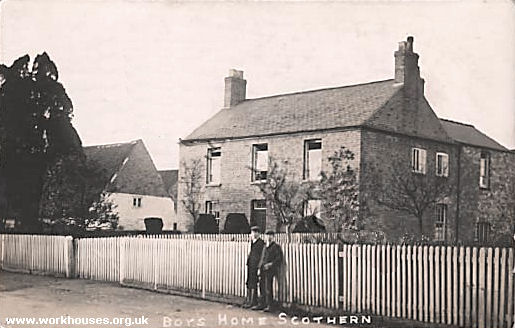
Scothern boys'home, early 1900s
Staff
Inmates
Records
Note: many repositories impose a closure period of up to 100 years for records identifying individuals. Before travelling a long distance, always check that the records you want to consult will be available.
- Lincolnshire Archives, St. Rumbold Street, Lincoln LN2 5AB. Holdings include: Guardians' minute books (1836-1930); Admissions and discharges (1839-43, 1871-1943); Births (1911-49); Baptisms (1827-62, 1900-45); Deaths (1911-44); Burials (1828-45, 1858-99); Children's Home admissions and discharges (1897-1920); etc.
Bibliography
- Rev ER Milton, Lincoln's House of Industry (pamphlet, date unknown)
Links
- None.
Acknowledgments
- Thanks to Lincolnshire Archives and to the Lincolnshire Echo for kindly providing archive pictures.
Unless otherwise indicated, this page () is copyright Peter Higginbotham. Contents may not be reproduced without permission.


